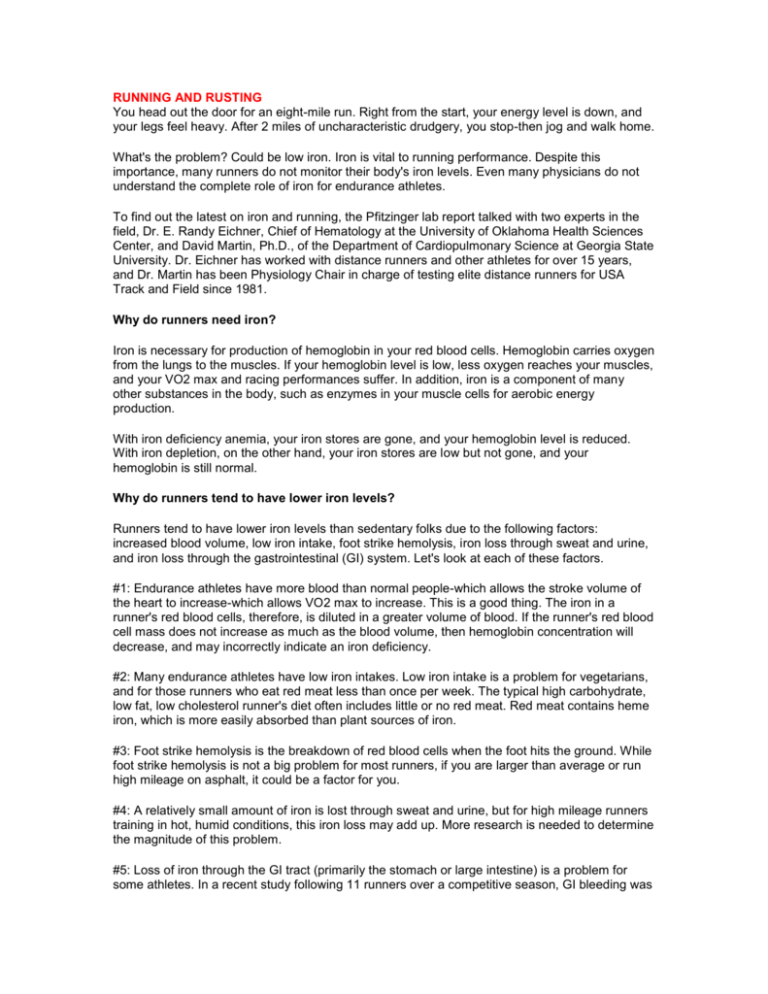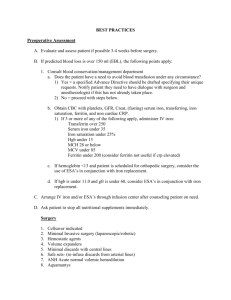Document 6988060
advertisement

RUNNING AND RUSTING You head out the door for an eight-mile run. Right from the start, your energy level is down, and your legs feel heavy. After 2 miles of uncharacteristic drudgery, you stop-then jog and walk home. What's the problem? Could be low iron. Iron is vital to running performance. Despite this importance, many runners do not monitor their body's iron levels. Even many physicians do not understand the complete role of iron for endurance athletes. To find out the latest on iron and running, the Pfitzinger lab report talked with two experts in the field, Dr. E. Randy Eichner, Chief of Hematology at the University of Oklahoma Health Sciences Center, and David Martin, Ph.D., of the Department of Cardiopulmonary Science at Georgia State University. Dr. Eichner has worked with distance runners and other athletes for over 15 years, and Dr. Martin has been Physiology Chair in charge of testing elite distance runners for USA Track and Field since 1981. Why do runners need iron? Iron is necessary for production of hemoglobin in your red blood cells. Hemoglobin carries oxygen from the lungs to the muscles. If your hemoglobin level is low, less oxygen reaches your muscles, and your VO2 max and racing performances suffer. In addition, iron is a component of many other substances in the body, such as enzymes in your muscle cells for aerobic energy production. With iron deficiency anemia, your iron stores are gone, and your hemoglobin level is reduced. With iron depletion, on the other hand, your iron stores are low but not gone, and your hemoglobin is still normal. Why do runners tend to have lower iron levels? Runners tend to have lower iron levels than sedentary folks due to the following factors: increased blood volume, low iron intake, foot strike hemolysis, iron loss through sweat and urine, and iron loss through the gastrointestinal (GI) system. Let's look at each of these factors. #1: Endurance athletes have more blood than normal people-which allows the stroke volume of the heart to increase-which allows VO2 max to increase. This is a good thing. The iron in a runner's red blood cells, therefore, is diluted in a greater volume of blood. If the runner's red blood cell mass does not increase as much as the blood volume, then hemoglobin concentration will decrease, and may incorrectly indicate an iron deficiency. #2: Many endurance athletes have low iron intakes. Low iron intake is a problem for vegetarians, and for those runners who eat red meat less than once per week. The typical high carbohydrate, low fat, low cholesterol runner's diet often includes little or no red meat. Red meat contains heme iron, which is more easily absorbed than plant sources of iron. #3: Foot strike hemolysis is the breakdown of red blood cells when the foot hits the ground. While foot strike hemolysis is not a big problem for most runners, if you are larger than average or run high mileage on asphalt, it could be a factor for you. #4: A relatively small amount of iron is lost through sweat and urine, but for high mileage runners training in hot, humid conditions, this iron loss may add up. More research is needed to determine the magnitude of this problem. #5: Loss of iron through the GI tract (primarily the stomach or large intestine) is a problem for some athletes. In a recent study following 11 runners over a competitive season, GI bleeding was evident in 17 of 129 stool samples after training, and in 16 of 61 stool samples after racing. The bleeding is fairly minor each time, but there may be a cumulative effect over years of running. So, the cards are stacked against runners in terms of iron. We tend to take in less, and lose more, than our sedentary peers. The highest risk occurs in pre-menopausal women runners, whose iron intake often does not meet their needs. How do you know if you have low iron? First of all, you will be dragging. Your heart rate may be elevated, and your enthusiasm for running will have sunk. You can only confirm your suspicions, however, with a blood test. You should find out both your hemoglobin and serum ferritin levels. Normal hemoglobin concentration ranges from 14 to 18 grams per 100 ml of blood for men, and 12 to 16 grams per 100 ml of blood for women, but for an endurance athlete, the lower end of normal should be extended by about 1 gram per 100 ml, due to our larger blood volume. Ferritin is a measure of your body's iron stores. Normal reference ferritin levels are 10-200 ng/ml for women and 10-300 ng/ml for men. Dr. Eichner and Dr. Martin have differing views on the relationship of ferritin to running performance. According to Dr. Eichner, ferritin is not directly related to performance, but if your ferritin level falls eventually your hemoglobin and performances will decline too. Low ferritin, therefore, can be viewed as an early warning sign. Dr. Martin, however, believes that ferritin reflects the iron stores that can be utilized to make enzymes for oxidative energy production, and therefore has a direct impact on performance. Dr. Martin says that in his experience with runners, training and racing performances are usually affected when ferritin levels drop below 20 ng/ml, and that when those athletes increase their ferritin levels above 25 ng/ml they experience a rapid turnaround in performance. Dr. Martin's view is based on years of experience working with runners. Dr. Eichner's view is supported by several studies, which have found no decline in performance with low ferritin but normal hemoglobin levels. Regardless of the mechanism involved, however, a low ferritin level is a red flag for a runner. How much iron do you need? According to the 1989 RDA, pre-menopausal women need about 15 mg of iron per day, whereas post-menopausal women and men require 10 mg of iron per day. Iron requirements have not been established for high mileage runners. As with any mineral, too much iron can be a health hazard. In fact, American men are more likely to get an iron overload than to be iron deficient. How can you prevent iron depletion? As with other running problems, such as injuries, the best strategy is to avoid low iron in the first place. Good food sources of iron include: liver, lean meat, oysters, egg yolk, dark green leafy vegetables, legumes, dried fruit, and whole grain or enriched cereals and bread. Dr. Eichner offers the following tips to prevent iron deficiency: 1. Eat 3 ounces of lean red meat or dark poultry a couple of times per week. 2. No coffee or tea with meals, because they reduce iron absorption. 3. Eat or drink vitamin C-rich foods with meals to increase iron absorption. 4. Use cast-iron cookware (particularly for acid foods like spaghetti sauce). Although these recommendations may seem like subtle changes in diet, they can have a powerful effect on your iron levels. For example, you will absorb three times as much iron from your cereal and toast if you switch from coffee to orange juice with breakfast. Both Dr. Eichner and Dr. Martin recommend taking iron supplements, in the form of ferrous sulfate, ferrous gluconate, or ferrous fumarate, only if necessary after making the recommended dietary changes. If you avoid red meat, and have been running for a few years, then you may have low iron stores. If you are a woman runner, the chance that you have low iron stores is substantially increased, and you may have a low hemoglobin level as well. Low iron may be the most prevalent nutritional deficiency in American runners. Before changing your diet or taking supplements, however, you should have your hemoglobin and ferritin levels checked. A lack of iron will have an immediate negative effect on your running performance. Fortunately, iron depletion and iron deficiency can be corrected, and, by following a few simple dietary principles can be prevented altogether. (This column originally appeared in Running Times Magazine.)






